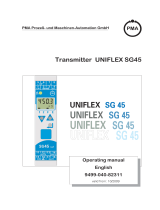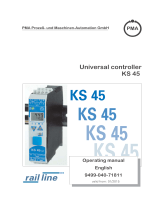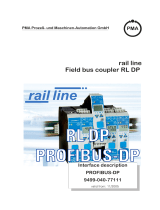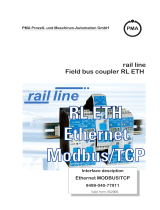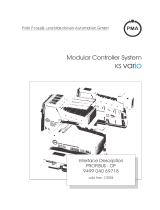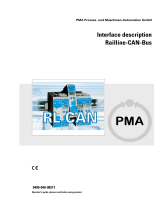Page is loading ...

BlueControl Insect
Climate
Technical Manual
614091 • 2023-11-24 Software version 8.3


BlueControl Insect
Technical Manual 3
Product and Documentation Changes
SKOV A/S reserves the right to change this document and the product herein described without further notice.
In case of doubt, please contact SKOV A/S.
The date of change appears from the front and back pages.
IMPORTANT
Notes concerning alarm systems
Breakdowns, malfunctions or faulty settings may cause substantial damage and financial losses when regulat-
ing and controlling the climate in a livestock house. It is therefore essential to install a separate, independent
alarm system that monitors the house climate concurrently with the climate and production controller. According
to EU-directive No. 98/58/EU, an alarm system must be installed in all mechanically ventilated houses.
We would like to draw your attention to the fact that the product liability clause of general terms and conditions
of sale and delivery specifies that an alarm system must be installed.
In case of an operating error or inappropriate use, ventilation systems can result in production
losses or cause loss of lives among livestock.
We recommend that ventilation systems should be mounted, operated and serviced only by
trained staff and that a separate emergency opening unit and an alarm system be installed as well
as maintained and tested at regular intervals, according to terms and conditions of sale and deliv-
ery.
Installation, servicing and troubleshooting of all electrical equipment must be carried out by quali-
fied personnel in compliance with the applicable national and international standard EN 60204-1
and any other EU standards that are applicable in Europe.
The installation of a power supply isolator is required for each motor and power supply to facilitate
voltage-free work on the electrical equipment. The power supply isolator is not included.
Note
• All rights belong to SKOV A/S. No part of this manual may be reproduced in any manner whatsoever without
the expressed written permission of SKOV A/S in each case.
• All reasonable efforts have been made to ensure the accuracy of the information contained in this manual.
Should any mistakes or imprecise information occur in spite of this, SKOV A/S would appreciate being noti-
fied thereof.
• Irrespective of the above, SKOV A/S shall not accept any liability with regard to loss or damage caused or
alleged to be caused by reliance on any information contained herein.
• Copyright by SKOV A/S.

BlueControl Insect
Technical Manual
1 Product description ....................................................................................................................................... 7
2 Work routine ................................................................................................................................................... 8
3 Installation guide............................................................................................................................................ 9
3.1 Selecting components............................................................................................................... 9
3.2 Slave relays ................................................................................................................................ 9
3.3 Setup of operation form ............................................................................................................ 9
3.4 View week number................................................................................................................... 10
3.5 Select type of Unit of measurements..................................................................................... 10
3.6 Connecting components......................................................................................................... 10
3.6.1 Installation wizard ...................................................................................................................... 10
3.6.2 The menu Show connection ...................................................................................................... 11
3.6.3 Manual I/O allocation ................................................................................................................. 11
3.7 Climate ...................................................................................................................................... 12
3.7.1 Air inlets ..................................................................................................................................... 12
3.7.2 Air outlet..................................................................................................................................... 12
3.7.2.1 Standard settings for stepless fan.............................................................................................. 12
3.7.2.2 Speed control............................................................................................................................. 12
3.7.2.2.1 Internal fan speed controller ...................................................................................................... 12
3.7.2.2.2 0-10 V speed control.................................................................................................................. 12
3.7.2.3 Dynamic MultiStep ..................................................................................................................... 13
3.7.2.4 Dynamic Air................................................................................................................................ 15
3.7.2.5 Setup for Dynamic Air ................................................................................................................ 15
3.7.2.6 Parking of fans ........................................................................................................................... 16
3.7.3 Recirculation .............................................................................................................................. 16
3.7.4 Heating....................................................................................................................................... 17
3.7.5 Setup of sensors ........................................................................................................................ 17
3.7.6 Active functions in the event of control failure............................................................................ 18
3.7.7 Setting of side cooling................................................................................................................ 18
3.8 Management ............................................................................................................................. 19
3.8.1 Batch start and batch stop controlled by an external system..................................................... 19
3.8.2 Set up equipment monitoring ..................................................................................................... 19
3.8.3 Auxiliary ..................................................................................................................................... 19
4 Calibration..................................................................................................................................................... 20
4.1 Calibration of Air Intake and Air Outlet.................................................................................. 20
4.1.1 Winch motor without feedback................................................................................................... 20
4.2 Calibration of climate sensors................................................................................................ 20
4.2.1 Calibration of pressure sensor ................................................................................................... 20
4.2.2 Calibration of CO2 sensor (installed as CO2 sensor) ................................................................ 21
4.2.3 Calibration of CO2 sensor (installed as auxiliary sensor) .......................................................... 22
4.2.4 Calibration of NH3 sensor.......................................................................................................... 22
4.2.5 Calibration of current sensor...................................................................................................... 22
5 Testing........................................................................................................................................................... 23
5.1 Testing basis components...................................................................................................... 23
5.1.1 Testing temperature and air humidity sensors........................................................................... 23
5.1.2 Testing Alarm............................................................................................................................. 23
5.2 Testing optional components: Manual control ..................................................................... 23
5.2.1 Testing climate functions ........................................................................................................... 24
5.2.1.1 Testing Air Intake and Air Outlet ................................................................................................ 24
5.2.1.2 Testing of Dynamic MultiStep .................................................................................................... 24
5.2.1.3 Stepless fans ............................................................................................................................. 25
5.2.1.4 MultiStep .................................................................................................................................... 25
5.2.1.5 Testing relay functions ............................................................................................................... 26
5.2.1.6 Emergency inlet ......................................................................................................................... 26
5.2.2 Testing management functions.................................................................................................. 27

BlueControl Insect
5.2.2.1 Testing of external batch start/batch stop .................................................................................. 27
5.2.2.2 Testing of current sensor ........................................................................................................... 27
5.2.2.3 Testing auxiliary sensor ............................................................................................................. 27
5.3 Testing network connection ................................................................................................... 28
6 Service........................................................................................................................................................... 29
6.1 Settings..................................................................................................................................... 29
6.1.1 Climate....................................................................................................................................... 29
6.1.1.1 Setting of exhaustion (MultiStep) ............................................................................................... 29
6.1.1.2 Fan settings ............................................................................................................................... 29
6.1.1.3 Stepless to step ......................................................................................................................... 30
6.1.1.4 Setting outside temperature limit ............................................................................................... 30
6.1.1.5 Setting of heating ....................................................................................................................... 31
6.1.2 Network settings ........................................................................................................................ 31
6.1.3 UTC time.................................................................................................................................... 32
6.2 Display ...................................................................................................................................... 32
6.3 Backup ...................................................................................................................................... 33
6.3.1 Backup of historical data............................................................................................................ 33
6.3.1.1 IMX based CPU module (2 LAN ports) ...................................................................................... 34
6.3.2 SD card and USB stick .............................................................................................................. 34
6.4 Software update ....................................................................................................................... 36
6.4.1 Preparing for a software update................................................................................................. 36
6.4.2 Carrying out the software update............................................................................................... 36
6.4.3 Check after software update ...................................................................................................... 37
6.5 Control parameters.................................................................................................................. 38
6.5.1 Control modes............................................................................................................................ 38
6.5.1.1 Adaptive control ......................................................................................................................... 38
6.5.1.2 P-band adjustment..................................................................................................................... 40
6.5.1.3 PID control ................................................................................................................................. 40
6.5.2 Ventilation .................................................................................................................................. 40
6.5.2.1 Cycle time .................................................................................................................................. 42
6.5.3 Heating....................................................................................................................................... 42
6.5.3.1 Adaptive heating control ............................................................................................................ 42
6.5.3.2 Room heating and stand-alone heater....................................................................................... 42
6.5.3.3 Floor heating .............................................................................................................................. 43
6.5.4 Cooling....................................................................................................................................... 44
6.5.4.1 Side cooling ............................................................................................................................... 44
6.5.5 Humidity ..................................................................................................................................... 44
6.5.5.1 Humidity control ......................................................................................................................... 44
6.5.5.1.1 Humidity control at adaptive ventilation mode ........................................................................... 45
6.5.5.1.2 Humidity control at PID ventilation mode ................................................................................... 45
6.5.5.1.3 Humidity control at adaptive heat mode..................................................................................... 45
6.5.5.1.4 Humidity control at PID heat mode ............................................................................................ 46
6.5.5.2 Humidification ............................................................................................................................ 46
6.5.5.3 Synchronizing with fans ............................................................................................................. 46
6.6 Adjustment of pressure........................................................................................................... 47
6.6.1 Adjusting negative pressure curve............................................................................................. 47
6.6.2 Setting change between roof and side ventilation ..................................................................... 48
6.6.3 Setting of minimum air inlet........................................................................................................ 48
6.6.4 Synchronization of room heating and air inlets .......................................................................... 49
6.6.5 Adjustment of stepless unit ........................................................................................................ 49
6.7 Curve for recirculation unit..................................................................................................... 50
6.8 System ...................................................................................................................................... 50
6.8.1 Resetting data............................................................................................................................ 50
7 Troubleshooting instructions ..................................................................................................................... 52
7.1 Temperature sensor control table.......................................................................................... 52
7.1.1 Table relating to DOL 114 temperature sensor control.............................................................. 52
Technical Manual

BlueControl Insect
Technical Manual
7.1.2 Table relating to DOL 12 temperature sensor control................................................................ 53
8 Technical data .............................................................................................................................................. 54
8.1 Dimensioned sketch ................................................................................................................ 55
9 Functionality ................................................................................................................................................. 56

BlueControl Insect
Technical Manual 7
1 Product description
BlueControl insect is a controller developed for insect farming systems with a focus on the soldier fly and meal-
worms. It is thus intended for breeding and growth of larvae and pupae, but can be adapted to most types of in-
sect farming systems.
Insect farming is an intensive form of production. The insects generate a lot of heat, just like the level of CO2
and NH3 can be high in the room. It requires efficient ventilation with high air change, which ensures good pro-
duction conditions throughout the house.
BlueControl insect meets the insects' special needs for climate control with recirculation, humidification, ventila-
tion boost and curve control on an hourly basis. The ventilation can be controlled as an equal pressure system
and as a central exhaust system.
The controller is available in two variants, both of which are used in a total insect ventilation system:
• BlueControl insect system (section ventilation)
• BlueControl insect central in/out (central exhaust and central air intake)
The controller is operated via a touch display with graphical views of the ventilation status, icons and curves,
among other things.

BlueControl Insect
8 Technical Manual
2 Work routine
This technical manual deals with the installation of the controller and is aimed primarily at the technicians and
electricians who will be mounting, installing and testing the controller.
According to current national and in Europe also EU regulations, the installation must be carried out by expert
personnel.
Note that electrical equipment may not be opened without removing the supply voltage, and only competent per-
sonnel may carry out servicing operations and troubleshooting.
The following checklist indicates the main points of the workflow regarding set up of the controller.
Mounting
1. Controller.
2. Emergency opening, if applicable.
Installation
1. Connect cables according to the circuit diagrams for the emergency opening of the system.
2. Set voltage in the controller.
3. Connect mains voltage to the controller.
4. Select components in the controller menu Installation | Installation wizard by reviewing all the in-
stallation menu items in the Installation wizard.
5. Connect the individual components by means of the controller's menu Installation | Show connec-
tion and the circuit diagrams.
6. Adjust the system.
7. Test the system.
Start-up
1. Setting and calibration.

BlueControl Insect
Technical Manual 9
3 Installation guide
3.1 Selecting components
There are two ways to install the controller.
At the initial installation: Use Installation wizard which will guide you through all the options of the functions.
If making adjustments to the existing installation: Use the menu Manual installation to go directly to the rel-
evant function.
Select components in the installation menu of the controller.
Installation | Installation wizard or Manual installa-
tion.
It is impossible to select more components than there are avail-
able I/O.
Therefore, you must observe that the controller accepts your re-
quests to connect a component.
If missing I/O, you can:
• Install extra I/O modules (if these are available).
• Uninstall components.
While functions are selected in the set-up menus Installation
and Show connection, all alarms will be delayed. Thus, no
alarms will be generated until 2 minutes after the last change is
completed n the installation menu.
It is indicated as info in the alarm menu for as long as the delay
is active.
However, it does not apply to alarms from CAN bus communi-
cation (I/O modules).
3.2 Slave relays
Using slave relays, the power may be distributed on multiple relays. This is especially useful if the power load is
larger than the max. current of the relays.
For several functions it is possible to select a slave relay which will work in the same way as the master relays -
however, with a delay of up to 1 sec. When the controller is set to Manual, the slave relays will also follow the
master relays.
For heating - when the master is 0-10 V output, the slave relay relay will switch on when the heating is switched
on.
3.3 Setup of operation form
Operation form Setting of operation form (continuous/batch production).

BlueControl Insect
10 Technical Manual
3.4 View week number
View week number View of week number at the top of all pages.
3.5 Select type of Unit of measurements
Unit of measurements The controller can display the units as both metric and US units.
3.6 Connecting components
The majority of the connection terminals are universal. Therefore, installing different components in the individ-
ual terminals is possible.
When you select a component from the menu Installa-
tion | Manual installation, the controller allocates I/O based on
a list. It means that the house controller selects the first avail-
able I/O on the list and that the components are allocated I/O in
the order they are selected.
The same I/O allocation in several controllers – i.e. when the in-
dividual components are connected to the same terminal num-
bers – is ensured by saving the set-up on a USB stick and en-
tering the set-up into several controllers.
3.6.1 Installation wizard
The installation wizard starts automatically the first time you activate the controller. The wizard provides a struc-
tured walk-through of the installation of the controller functions. We recommend that it be used for installation.
It supports the necessary selections and settings to set up the controller.
Choose between:
•Installation wizard: A complete installation walk-through.
•Manual installation: Installation or adjustment of a specific
function, for example, cooling. A few changes can be saved
here.
Press the buttons in the upper right corner to move one step
forward or backward in the installation.
Press the X in the upper left corner to finish the installation be-
fore completing all steps.
Press Cancel to finish without saving.
Press Confirm to save changes.
Also, see the section Work Routine for an overview of the com-
plete procedure of setting up the controller.

BlueControl Insect
Technical Manual 11
3.6.2 The menu Show connection
When you have selected all the components in the installation menu, the controller will show you where to con-
nect the individual components.
See the menu Show connection for where exactly to connect the individual components.
When a wiring diagram in the Circuit Diagrams and Cable Plans reads "See Show connection", it refers to this
menu.
3.6.3 Manual I/O allocation
If you want to determine the I/O allocation for one or more components, you can manually change it under the
menu option Manual I/O allocation.
Select the menu Installation | Manual I/O allocation
and press the component to be changed.
Choose between the listed terminals. Note whether a terminal is
already allocated to another function.
Press the required terminal.
If you use a terminal currently used by another function, the
controller will change the I/O allocation for this function.
In the menu Show connection, ensure that the controller moves
the first allocated function to another terminal.
The controller will change the I/O allocation instantly.
If the I/O allocation can be changed, the controller will accept it.
If the I/O allocation cannot be changed, the controller will reject
it, and the I/O allocation will remain unchanged.

BlueControl Insect
12 Technical Manual
3.7 Climate
3.7.1 Air inlets
The house controller includes different types of air intake:
Roof inlet Air inlet in the roof which regulates via a flap, a fan and a recirculation fan.
Side inlet E.g. wall inlets regulated by a winch motor.
A combination of the two types of air inlets allows the possibility to accommodate an increasing need for ventila-
tion by automatic adjustment of the ventilation mode.
3.7.2 Air outlet
3.7.2.1 Standard settings for stepless fan
The controller has a number of default settings for a variety of fan types.
When you choose to load a standard setting, no further fan setting is required.
Select the menu Technical | Installation | Manual installation | Climate | Ventilation | Air outlet |
Side outlet | Stepless | Load stepless fan settings.
Select the required fan type.
The setup can be viewed and customized in the menu Techni-
cal | Service | Stepless | Adjust stepless. See also section Ad-
justment of stepless unit [}49].
3.7.2.2 Speed control
3.7.2.2.1 Internal fan speed controller
With an internal fan speed controller, it is necessary to enter the typical voltage of the mains supply to obtain the
correct control of the fan. Measure the voltage by means of a voltmeter or possibly contact an electrician.
Select the menu Technical | Installation | Manual installation | Climate| Ventilation | Air outlet|
Select a type of outlet | Fan speed control
Power supply Enter the typical mains supply voltage to obtain correct control of the fan.
3.7.2.2.2 0-10 V speed control
When the fan is controlled by a 0-10 V speed control, voltages must be set corresponding to the fan stopped
and the fan running at full speed. This settings will depend on the type of fan speed controller used.
Select the menu Technical | Installation | Manual installation | Climate | Ventilation | Air outlet|
Select a type of outlet | Fan speed control
Stop fan Voltage at 0 % fan capacity.
Full speed Voltage at 100 % fan capacity.
Note that the factory setting for both menu items is 5.0 V. The controller will send an alarm if the settings are not
adjusted.

BlueControl Insect
Technical Manual 13
3.7.2.3 Dynamic MultiStep
See the section Setting of Exhaustion (MultiStep) for a general description of MultiStep.
Dynamic MultiStep makes it possible to reduce power consumption for the fans in the MultiStep system. It is
achieved by the fans' ability to run at two speeds (Low and High) and by letting them run as long as possible at
low speed.
When a low level of ventilation is needed ventilation is carried out as an ordinary MultiStep system, but the fan
output is limited so that it can only provide a percentage of the fan's maximum capacity.
All exhaust units that are set up to run only in the low area in the Dynamic MultiStep system must be able to run
at reduced capacity.
At a high ventilation requirement, the fan output varies steplessly from low to full speed and the flaps are fully
open.
0-10 volt output
The 0-10 V output makes it possible to run at low speeds on the
fan, and from here to run the fan steplessly up to full speed.
Low speed and Full speed
When a fan connect to a 0-10 V output has been selected, a
voltage value must be set which corresponds to the fan running
at low and full speed.
Please note that most fan types have stopped at 10 volt.
Depending on which type of fan has been selected, the voltage
is set at low speed to 4-6 volts.
For each MultiStep unit, set whether it should be activated
when the Dynamic MultiStep system runs at high speed, at low
speed, or with both.

BlueControl Insect
14 Technical Manual
Ventilation sequence
The livestock house's ventilation system
Flap in stepless unit: The stepless ventilation sequence is
achieved by opening and closing the flap.
Fan in stepless unit: The stepless fan runs as long as possible at
low speed.
Variable ON/OFF: 0- 10 V control signal to fan in stepless ON/
OFF.
Max. output in % at low and high regulation.
Method of Operation
1 stepless unit
2 MultiStep units
From low to high regulation
Figure1: Principle diagram of Dynamic MultiStep system.
Outputs Low High
Stepless unit 8.5 13
MultiStep 1 8.5 13
MultiStep 2 17 26
34 52
Table1: Examples of outputs

BlueControl Insect
Technical Manual 15
3.7.2.4 Dynamic Air
Dynamic Air is installed by choosing a number of sensors placed on the stepless unit. For each stepless unit, a
number of chimneys controlled in parallel and a number of Dynamic Air sensors can be used.
Measuring the varying stepless output provides an accurate expression of the output of the ventilation system
according to which regulation can be carried out by varying fan revolutions/the flap position.
Air outlet 1-1
Air outlet 2-1
1-16 air outlet
1-16 air outlet
1-3 sensors
1-3 sensors
Technically, one sensor is sufficient for 6 air outlets, but SKOV A/S usually recommends that a Dynamic Air
sensor is installed in every other stepless exhaust unit in order to ensure optimum regulation conditions. The cli-
mate controller regulates stepless air outlet without sensors based on a calculated output.
3.7.2.5 Setup for Dynamic Air
Dynamic Air mode Dynamic Air makes it possible to regulate the stepless air outlet in order to carry
out the correct air change.
• In livestock houses with direct exhaustion, fan speed is regulated.
• In livestock houses with a duct system, the flap is regulated (according to a
curve value). See also the section Adjustment of stepless unit [}49].
Selection of regulation mode for Dynamic Air:
Dynamic Flow: Measurement of the actual amount of air.
Dynamic Control: Measurement and control of the actual amount of air.
Please pay attention to the fact that you can only select Dynamic Control if a fan
speed controller is employed.
Chimney type Choice of in which type of air outlet the Dynamic Air sensor is placed, so that cli-
mate controller can adjust the air measurement according to the dimensions of
the air outlet.
Minimum fan speed When applying Dynamic Control and frequency-controlled stepless speed control
(0-10 V), a minimum fan speed can be entered, so it does not run too slowly.
Although Dynamic Control has been selected, it is important that the curve values
of the fan in the stepless outlet are also set, due to the fact that climate controller
will regulate according to these values in case of an error situation.
Maximum fan speed

BlueControl Insect
16 Technical Manual
To ensure that the chimney can provide the necessary air output, the climate controller will increase the flap
opening by 2% pr. minute (in relation to the stepless curve), if the fan has been running at maximum speed for
more than 1 minute.
In the same way the climate controller will reduce the flap opening by 2% pr. minute (in relation to the stepless
curve) when the fan speed is 10% below the maximum speed for 1 minute. This helps to ensure that the flap po-
sition is stable and does not alternate between opening and closing.
3.7.2.6 Parking of fans
With this function, fans can be taken temporarily out of service. This can, for example, be used in cold periods
where some fans are closed for insulation purposes, or if a fan is defective and awaiting repair.
The function is available in the LPV and CT variants and for all type of ON/OFF MultiStep.
We recommend that you use parking of fans which are not in use as this will enable the ventilation regulation to
automatically adapt to the altered ventilation capacity.
Please not that if a MultiStep is set up to be active in case of failure, the controller will try to start it in case of
failure no matter if it is parked. See also the section Active functions in the event of control failure [}18].
3.7.3 Recirculation
As a recirculation unit, two groups of fans are used located in horizontal chimney ducts with flaps. Each group
blows the air one way and the other way, respectively.
By running the 2 fan groups alternately, the air direction in the house can be reversed. This ensures that the
temperature and air humidity can be kept at the required level.
1 to 2 recirculation
2 to 1 recirculation
1
2
2
1
Figure2: The air direction is indicated as “1 to 2” or “2 to 1”.
1 to 2 recirculation
2 to 1 recirculation
All fans and flaps in each group are controlled by the same signal.
A temperature sensor is placed on each side, in that way the house controller can
calculate the temperature difference between the 2 sides.
It is important that the location and connection of the temperature sensors match the
location and connection of recirculation units so that the air direction is as required.
See also the section about Speed control [}12].
Control of cooling and humidification in relation to recirculation direction
A direction relay can control that cooling and humidification is only active on the side from which recirculation
takes place.
Direction relay The relay switches every time the recirculation direction changes.

BlueControl Insect
Technical Manual 17
Synchronization of recirculation in more sections
A controller can regulate a section which is up to 30 meters long. If the section is longer, several controllers
must be used, which are set up to run the recirculation synchronously.
When the recirculation direction switches in one section, the other sections will switch to the same direction si-
multaneously.
The function can only be used on farms where the controllers are connected through a LAN network and where
the management program FarmOnline Explorer is used
In FarmOnline Explorer, the controllers must be included in the same configuration. In this way, they have ac-
cess to data from each other. See the section Network settings [}31] for the setup of the controllers in a net-
work and see the FarmOnline Explorer Technical Manual for creating a configuration.
The workflow is as follows:
1. Connect the controllers to the LAN network.
2. Create a configuration in FarmOnline Explorer where the controllers are included.
3. Setup the the synchronization in the controller menu Installation | Manual installation | Climate | Recircu-
lation.
Select the number of sections.
Associate each section with a controller by selecting its IP address.
Silos must be set up in all the connected controllers.
3.7.4 Heating
Room heating can be regulated as common or individual heating, depending on the number of temperature sen-
sors (not for Heat controlled by own sensor).
Common regulation: A sensor combination with a common setpoint for all room heaters
Individual regulation: A sensor combination for each room heater.
Heat control
(only house heaters)
Choose whether heat sources 1 and 2 should start in parallel or sequentially.
Heat distribution Distribution of capacity between heat sources 1 and 2 (for separate heat control only)
Sequential heating is typically used when there are two different heat sources in the
house.
For example:
• heating pipes and air heaters
• heating pipes and blow heater as extra capacity
It is important to distribute correctly between the two types of heat sources, in order to
obtain a steady heat control. The heating system’s dimensions and output determine the
actual distribution.
3.7.5 Setup of sensors
Temperature sensor se-
lection
Location of temperature sensors for ventilation and heat control.
You can set up several temperature sensors in the livestock house to register the
temperature in each zone.

BlueControl Insect
18 Technical Manual
No. of auxiliary sensors Select a number of auxiliary sensors.
Auxiliary sensor setup Select the required type of auxiliary sensor.
Name the auxiliary sensor according to function to make it recognizable in alarms
and other info.
3.7.6 Active functions in the event of control failure
When installing MultiStep air outlet and side cooling, you must decide how these functions is to react in an
emergency situation.
MultiStep outlets
Activated: When the control fails, the air outlet is active.
Deactivated: When the control fails, the air outlet is inactive.
3.7.7 Setting of side cooling
Cooling mode If there are more cooling pumps, they can be set to running either sequentially or in
parallel.
Side cooling relay ratio Side cooling features up to three relays.
The percentage share between cooling relays that are controlled sequentially.
E.g. with two relays: 50 %/50 %
The controller automatically calculates the percentage share for relay 1.
Side cooling
Activated: When the control fails, side cooling is active and runs
until the emergency situation is over.
Deactivated: When the control fails, the side cooling is not ac-
tive.
Note that in an emergency situation the controller cannot regulate according to temperature and humidity.
If you select Yes (Active at failure), side cooling runs no matter whether the temperature is too low and
humidity is too high in the house.
Note also that a combination of a high inside temperature and high air humidity can be life-threatening to
the animals.

BlueControl Insect
Technical Manual 19
3.8 Management
3.8.1 Batch start and batch stop controlled by an external system
In insect houses, where an automatic logistics system controls placement and emptying of the house, you can
choose to let batch start/batch stop be controlled by the external system.
The external system determines the status of the house and how the ventilation is controlled.
See also section Testing of external batch start/batch stop [}27].
3.8.2 Set up equipment monitoring
Select number of current sensors.
Then select the function to be monitored by each sensor. One
function, for example, MultiStep 3 can be associated with multi-
ple current sensors.
The function can be named for recognition in alarm log and
overview.
3.8.3 Auxiliary
No. of auxiliary sensors Select a number of auxiliary sensors.
Auxiliary sensor setup Select the required type of auxiliary sensor.
Name the auxiliary sensor according to function to make it recognizable in alarms
and other info.

BlueControl Insect
20 Technical Manual
4 Calibration
4.1 Calibration of Air Intake and Air Outlet
The controller must be adapted to the winch motor after installation.
Winch motors with feedback must be calibrated by a technician, while winch motors without feedback are cali-
brated automatically once the technician has set up a time for Air inlet time.
During the automatic calibration, the air inlets/air outlets open and close completely for a short time and then re-
turn to the position which the controller calculates.
The change-over switch on the winch motor must be se to AUT.
4.1.1 Winch motor without feedback
Time Setting of the time of day when the automatic calibration shall run.
Running time Setting of the time it takes to run from fully open to fully closed.
Runs before recalibra-
tion
Setting of the number of times the inlet flap has to run before it calibrates automati-
cally.
Minimum voltage
Maximum voltage
When the air inlets or air outlets are 0-10 V controlled, the output voltage can be ad-
justed via min. voltage and max. voltage.
1. Select the menu Calibration | Climate | Side inlet | Calibration
2. Select ON to start calibration.
3. Check that the correct inlet(s) open(s) and close(s) correctly.
4. Wait until the calibration is finished and the display shows Calibration ended again.
Calibration of other air inlets and air outlets are carried out in the same way.
4.2 Calibration of climate sensors
Temperature and humidity
The connected temperature and humidity sensors can be calibrated using an offset.
If, in connection with manual measurements, the current value is measured to a level that differs from the regis-
trations provided by the installed sensors, you can adjust the read-out value so that it corresponds to your ob-
servation.
0-10V sensors
Adapt the controller to the sensors after installation.
When a sensor is 0-10 V controlled, you can adjust the output voltage via Minimum voltage and Maximum volt-
age.
When Min. value and Max. value are set, you should also indicate the range within which the sensor can mea-
sure.
4.2.1 Calibration of pressure sensor
Depending on the control type (positive pressure/negative pressure), for which the DOL 18 pressure sensor is to
be used, it must be installed and adjusted in different ways.
When installing the pressure sensor, dip switches must be set up and tubes must be placed. Also see the Cir-
cuit Diagrams and Cable Plans document.
/
